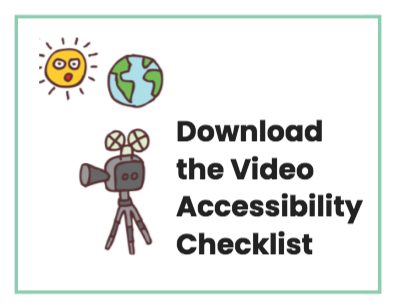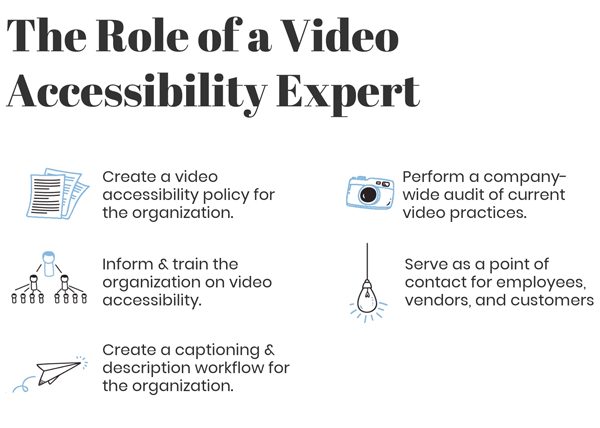How to Centralize Video Accessibility Efforts at Your Organization
Updated: August 25, 2023
Unfortunately, not all the video being produced today is accessible to everyone.
Lack of captions, transcripts, and audio description inhibit a large portion of the population from enjoying and interacting with your video content.
Often, accessible content is put on the back burner for reasons such as an organization doesn’t have a budget or is simply not aware of the legal requirements.
Ultimately, many organizations fail to realize the value of accessible content for a wider audience, not just for individuals with a disability.
What is video accessibility?
Accessible video includes captions, transcripts, audio description, and an accessible media player that supports these features.
Unfortunately, many video players fail to meet the essential elements of an accessible video player. Many don’t support audio description or transcripts and are polluted with keyboard traps.
In order to avoid producing inaccessible video, it’s important to consider all elements of accessibility before production.
How to start centralizing video accessibility
As you implement more video accessibility practices into your video production, try making an effort to centralize the process.
Centralizing video accessibility will help you get organized, save time, and manage your budget.
1. Build a Foundation

Key takeaways:
- Hire or train a video accessibility expert for your organization.
- Create a video accessibility policy.
- Begin communicating your commitment to accessibility to the members of your organization.
The best way to start is by hiring or training a video accessibility expert for your organization. If you have more resources, or you work with a lot of video content, you can also build a team of video accessibility experts.
The goal is to have a point of contact at your organization who can be in charge of your initiative.
With your video accessibility expert and policy in place, you’ll want to start building awareness throughout your organization of your new commitment to accessibility.
You can send an email, create a video, or host a presentation.
2. Understand your video culture

Key takeaways:
- Make a list of who and where video is being created at your organization.
Depending on your industry, company, or service offering, video creation can happen within a single department or multiple departments.
For example, if you work at a university, video is created by multiple departments, individual teachers, marketing, and even students. On the other hand, if you work for a smaller company, perhaps only the marketing department is creating video.
One of the biggest challenges in centralizing video accessibility is communication. That is why noting who is creating video, how much and where video is being created is an essential step in helping to overcome this.
Once you have your list handy, you’ll be able to disseminate information more effectively.
3. Create a video a11y workflow

Key takeaways:
- Create a captioning and description workflow that all employees can use.
- A centralized workflow will help alleviate the concerns of employees who feel like these new requirements interrupt their workflow.
- Opt for a captioning and description vendor who allows multiple users, departments, or permissions under one umbrella account.
- Look for captioning or description vendors that offer integrations with major video platforms.
Having a centralized workflow will help alleviate the concerns of employees who feel like these new video requirements interrupt their workflow and interfere with the delivery of their job.
Depending on the amount of video content that your organization publishes and your budget, captioning and audio description can be done in-house or outsourced to a professional company.
Your workflow should be clearly laid out and explained to each video creator in your organization. Once you’ve established a solution, take time to walk each employee through the process to avoid confusion.
The most effective workflows are optimized to how your company functions. You can either give content creators access to a captioning or description account or have them submit videos to your accessibility office or video accessibility expert.
The goal is to create a universal process that all departments and individuals can follow.
When choosing a captioning or description company, there are several important characteristics to keep in mind. A good captioning or audio description company will let you have multiple users, departments, or permissions under one account. This makes it easier to manage and organize the varied projects coming in across an organization.
Also, look for a captioning or description company that offers integrations. For example, at 3Play Media, our roundtrip integrations allow users to tag 3Play Media on the video they want captioned, and we’ll then create the captions and automatically post them back to the video. Essentially, integrations save the video creater a ton of time and make the captioning process infinitely easier.
4. Audit your video content

Key takeaways:
- Ensure you have an accessible video player or find a solution to provide equivalent alternatives to your content.
- Rank and prioritize your videos for captioning and description.
- Link you video player accounts to your captioning and description solution
First, take a look at the video player you are using. An accessible video player supports captions, transcripts, and audio descriptions. It's also fully keyboard, screen reader, and mouse accessible.
An accessible video player also gives users the tools to pause, stop, and control the volume of the video. Some go as far as allowing users to customize the size, font, and color of the captions.
If you don’t have access to a fully accessible video player, it’s important to always provide equivalent alternatives. If captions aren’t supported on your video player, you can use a captions plugin, or burn the captions into the video. Similarly, with audio description, you can use an audio description plugin, or create a separate video track.
Next, you'll want to prioritize videos for captioning and audio description. Ideally, if you have the budget, you want to caption and describe all your videos.
Otherwise, you can rank your videos by popularity, then prioritize captioning and description for the most popular ones. Once you have more funds, you can work to make the less pertinent videos accessible as well.
Centralization takes time
Implementing a video accessibility process will take time.
But with centralization, the goal is that eventually, video accessibility will become part of your organization.
As with most things, you must first face the upfront expenses to later reap the benefits.








